Related Research Articles
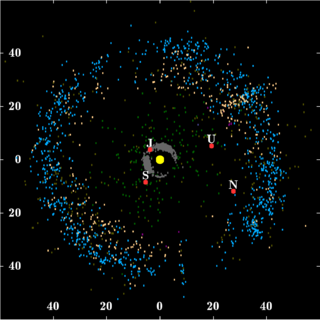
In planetary astronomy, a centaur is a small Solar System body that orbits the Sun between Jupiter and Neptune and crosses the orbits of one or more of the giant planets. Centaurs generally have unstable orbits because they cross or have crossed the orbits of the giant planets; almost all their orbits have dynamic lifetimes of only a few million years, but there is one known centaur, 514107 Kaʻepaokaʻawela, which may be in a stable orbit. Centaurs typically exhibit the characteristics of both asteroids and comets. They are named after the mythological centaurs that were a mixture of horse and human. Observational bias toward large objects makes determination of the total centaur population difficult. Estimates for the number of centaurs in the Solar System more than 1 km in diameter range from as low as 44,000 to more than 10,000,000.

A proplyd, short for ionized protoplanetary disk, is an externally illuminated photoevaporating protoplanetary disk around a young star. Nearly 180 proplyds have been discovered in the Orion Nebula. Images of proplyds in other star-forming regions are rare, while Orion is the only region with a large known sample due to its relative proximity to Earth.
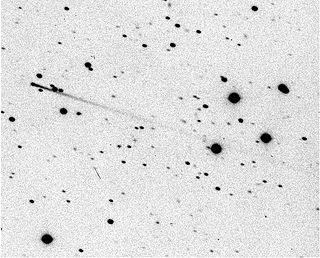
Comet Elst–Pizarro is a body that displays characteristics of both asteroids and comets, and is the prototype of active asteroids. Its orbit keeps it within the asteroid belt, yet it displayed a dust tail like a comet while near perihelion in 1996, 2001, and 2007.
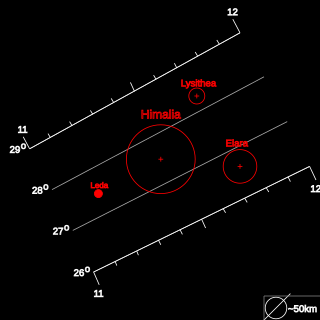
The Himalia group is a group of prograde irregular satellites of Jupiter that follow similar orbits to Himalia and are thought to have a common origin.

Neptune trojans are bodies that orbit the Sun near one of the stable Lagrangian points of Neptune, similar to the trojans of other planets. They therefore have approximately the same orbital period as Neptune and follow roughly the same orbital path. Thirty-one Neptune trojans are currently known, of which 27 orbit near the Sun–Neptune L4 Lagrangian point 60° ahead of Neptune and four orbit near Neptune's L5 region 60° behind Neptune. The Neptune trojans are termed 'trojans' by analogy with the Jupiter trojans.
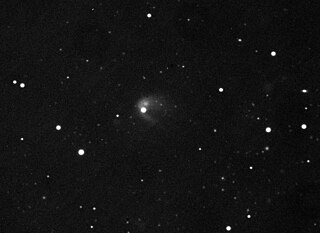
Active asteroids are small Solar System bodies that have asteroid-like orbits but show comet-like visual characteristics. That is, they show a coma, tail, or other visual evidence of mass-loss, but their orbits remain within Jupiter's orbit. These bodies were originally designated main-belt comets (MBCs) in 2006 by astronomers David Jewitt and Henry Hsieh, but this name implies they are necessarily icy in composition like a comet and that they only exist within the main-belt, whereas the growing population of active asteroids shows that this is not always the case.

Epsilon Eridani b, also known as AEgir [sic], is an exoplanet approximately 10.5 light-years away orbiting the star Epsilon Eridani, in the constellation of Eridanus. The planet was discovered in 2000, and as of 2023 remains the only confirmed planet in its planetary system. It orbits at around 3.5 AU with a period of around 7.6 years, and has a mass around 0.6 times that of Jupiter. As of 2023, both the Extrasolar Planets Encyclopaedia and the NASA Exoplanet Archive list the planet as 'confirmed'.

3451 Mentor is a large Jupiter trojan from the Trojan camp, approximately 120 kilometers in diameter. It was discovered on 19 April 1984, by Czech astronomer Antonín Mrkos at the Kleť Observatory in the Czech Republic. The uncommon Jovian X-type asteroid is one of the largest Jupiter trojans and has a rotation period of 7.7 hours. It was named after Mentor from Greek mythology. Mentor, a man who was rich in horse at Pedaeus. He was the father of the spearman Imbrius, an ally of the Trojans.

An interstellar object is an astronomical object in interstellar space that is not gravitationally bound to a star. This term can also be applied to an object that is on an interstellar trajectory but is temporarily passing close to a star, such as certain asteroids and comets. In the latter case, the object may be called an interstellar interloper.
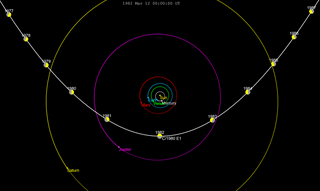
C/1980 E1 is a non-periodic comet discovered by Edward L. G. Bowell on 11 February 1980 and which came closest to the Sun (perihelion) in March 1982. It is leaving the Solar System on a hyperbolic trajectory due to a close approach to Jupiter. In the 43 years since its discovery only two objects with higher eccentricities have been identified, 1I/ʻOumuamua (1.2) and 2I/Borisov (3.35).
Scholz's Star is a dim binary stellar system 22 light-years from the Sun in the constellation Monoceros near the galactic plane. It was discovered in 2013 by astronomer Ralf-Dieter Scholz. In 2015, Eric Mamajek and collaborators reported the system passed through the Solar System's Oort cloud roughly 70,000 years ago, and dubbed it Scholz's Star.
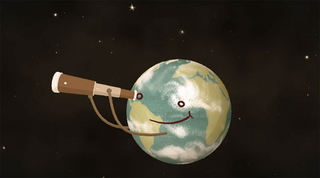
Backyard Worlds: Planet 9 is a NASA-funded citizen science project which is part of the Zooniverse web portal. It aims to discover new brown dwarfs, faint objects that are less massive than stars, some of which might be among the nearest neighbors of the Solar System, and might conceivably detect the hypothesized Planet Nine. The project's principal investigator is Marc Kuchner, an astrophysicist at NASA's Goddard Space Flight Center.

ʻOumuamua is the first interstellar object detected passing through the Solar System. Formally designated 1I/2017 U1, it was discovered by Robert Weryk using the Pan-STARRS telescope at Haleakalā Observatory, Hawaii, on 19 October 2017, approximately 40 days after it passed its closest point to the Sun on 9 September. When it was first observed, it was about 33 million km from Earth and already heading away from the Sun.

(323137) 2003 BM80, provisional designation: 2003 BM80 and cometary designation 282P/2003 BM80, is an asteroid and main-belt comet from the outer regions of the asteroid belt, approximately 9.4 kilometers (5.8 miles) in diameter. It was discovered on 31 January 2003, by astronomers of the LONEOS program conducted at Anderson Mesa Station near Flagstaff, Arizona, in the United States.

Valetudo, also known as Jupiter LXII and originally known as S/2016 J 2, is an irregular moon of Jupiter. It was discovered by Scott S. Sheppard and his team in data acquired by the 6.5-m Magellan-Baade telescope of the Las Campanas Observatory in 2016, but was not announced until 17 July 2018, via a Minor Planet Electronic Circular from the Minor Planet Center, which also reported the discovery of nine other of Jupiter's moons. Besides data from Las Campanas, the original announcement also referred to data acquired through the 8.1-m Gemini North telescope of the Mauna Kea Observatories as well as the 4.0-m reflector of the Cerro Tololo Inter-American Observatory.

2I/Borisov, originally designated C/2019 Q4 (Borisov), is the first observed rogue comet and the second observed interstellar interloper after ʻOumuamua. It was discovered by the Crimean amateur astronomer and telescope maker Gennadiy Borisov on 29 August 2019 UTC.
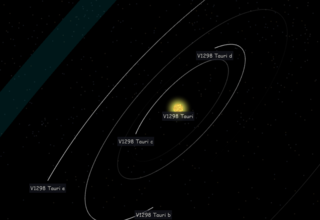
V1298 Tauri is a young weakly-lined T Tauri star that is part of the Taurus-Auriga association in the Taurus Molecular Cloud. Alternatively it is part of a proposed moving group, called Group 29 that is slightly older. The system has four transiting exoplanets, discovered with the Kepler space telescope in the K2 mission. One of the planets was discovered in August 2019 and the other three were discovered in November 2019 by the same team.

P/2019 LD2 (ATLAS) is a Jupiter-family comet discovered by the Asteroid Terrestrial-impact Last Alert System on 10 June 2019. It was initially reported as the first known Jupiter trojan asteroid to display cometary activity, but its classification as a Jupiter trojan was retracted after closer examination and a longer observation arc revealed its orbit to be unstable like a typical Jupiter family comet and implied that its position near the trojans is temporary.
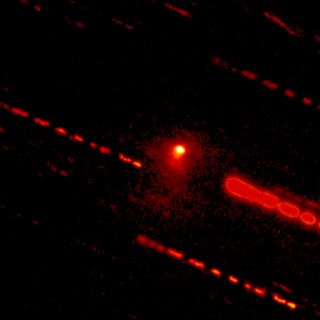
C/2014 OG392 (PanSTARRS) is a comet discovered as a centaur on 28 July 2014 when it was 11.5 AU (1.72 billion km) from the Sun and had an apparent magnitude of 21. The comet was relatively easier to detect at this distance because the nucleus is estimated to be 20 km in diameter.

(248370) 2005 QN173 is a main belt asteroid that undergoes recurrent comet-like activity near perihelion, and is now designated comet 433P/(248370) 2005 QN173. This object was discovered on 29 August 2005 by the Near-Earth Asteroid Tracking program at Palomar Observatory. It orbits in the outer main asteroid belt with an orbital period of 5.36 years, a semi-major axis of 3.06 AU, and an orbital eccentricity of 0.225, bringing it as close as 2.37 AU to the Sun at perihelion. The orbital plane is inclined at an angle of 0.068° to the ecliptic.
References
- 1 2 3 4 5 Toth, I. (March 2006). "The quasi-Hilda subgroup of ecliptic comets - an update". Astronomy and Astrophysics. 448 (3): 1191–1196. Bibcode:2006A&A...448.1191T. doi: 10.1051/0004-6361:20053492 .
- ↑ Spratt, Christopher E. (December 1989). "The Hilda group of minor planets". Journal of the Royal Astronomical Society of Canada. 83: 393–404. Bibcode:1989JRASC..83..393S.
- ↑ Cheng, Y. -C.; Ip, W. -H. (2012-05-01). "Physical and dynamical properties of a quasi-Hilda comet , 212P/2000YN30". 1667: 6462.
{{cite journal}}: Cite journal requires|journal=(help) - ↑ García-Migani, E.; Gil-Hutton, R. (2018-10-01). "The activity and dynamical evolution of quasi-hilda asteroid (457175) 2008 GO98". Planetary and Space Science. 160: 12–18. doi:10.1016/j.pss.2018.03.011. ISSN 0032-0633.
- ↑ Chandler, Colin Orion; Oldroyd, William J.; Trujillo, Chadwick A. (2022-08-01). "Migratory Outbursting Quasi-Hilda Object 282P/(323137) 2003 BM80".
{{cite journal}}: Cite journal requires|journal=(help) - ↑ Jewitt, David; Kim, Yoonyoung (2020-12-01). "Outbursting Quasi-Hilda Asteroid P/2010 H2 (Vales)". The Planetary Science Journal. 1: 77. arXiv: 2010.05012 . doi: 10.3847/PSJ/abbef6 . ISSN 2632-3338.
- ↑ Oldroyd, William J.; Chandler, Colin Orion; Trujillo, Chadwick A.; Burris, William A.; Kueny, Jay K.; Hsieh, Henry H.; Farrell, Kennedy A.; DeSpain, Jarod A.; Mazzucato, Michele T.; Bosch, Milton K. D.; Shaw-Diaz, Tiffany; Gonano, Virgilio (2023-03-01). "Comet-like Activity Discovered on Quasi-Hilda Asteroid 2009 DQ118". Research Notes of the American Astronomical Society. 7: 42. doi: 10.3847/2515-5172/acc17c . ISSN 2515-5172.
- ↑ Trujillo, Chadwick A.; Chandler, Colin Orion; Oldroyd, William J.; Burris, William A.; Hsieh, Henry H.; Kueny, Jay K.; Mazzucato, Michele T.; Bosch, Milton K. D.; Shaw-Diaz, Tiffany; Gonano, Virgilio (2023-05-26). "Cometary Activity on Quasi-Hilda Object 2018 CZ16". Research Notes of the AAS. 7 (5): 106. doi: 10.3847/2515-5172/acd7f0 . ISSN 2515-5172.
- ↑ Chandler, Colin Orion; Oldroyd, William J.; Trujillo, Chadwick A.; Burris, William A.; Hsieh, Henry H.; Kueny, Jay K.; Farrell, Kennedy A.; DeSpain, Jarod A.; Sedaghat, Nima; Magbanua, Mark Jesus Mendoza; Sheppard, Scott S.; Mazzucato, Michele T.; Bosch, Milton K. D.; Shaw-Diaz, Tiffany; Gonano, Virgilio (November 2023). "New Active Quasi-Hilda Asteroid 2004 CV50: A Citizen Science Discovery". Research Notes of the AAS. 7 (11): 237. doi: 10.3847/2515-5172/ad09c1 . ISSN 2515-5172.